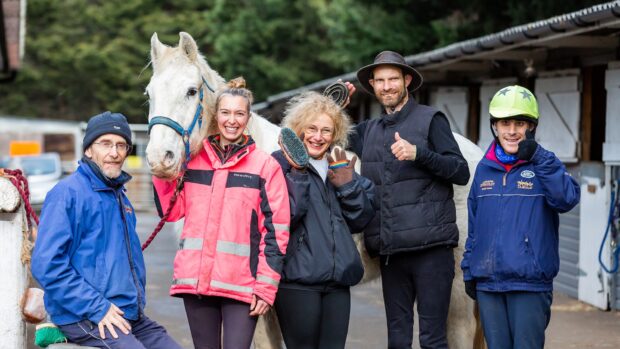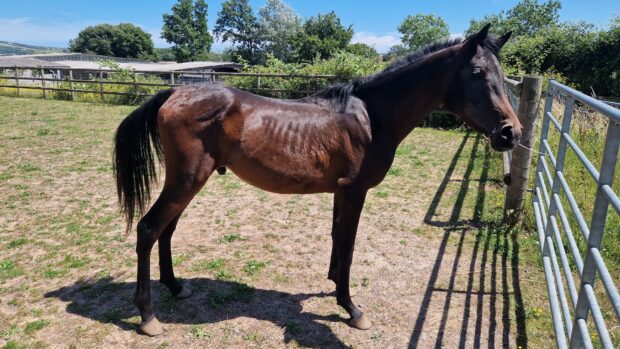Studies into the equine genome face a shortage of industry funds after the British Horseracing Board slashed its contributions to veterinary research for 2005. Although the Board managed to put together some funding to support the ongoing Equine Genetics Research project at the Animal Health Trust, a new project from the Royal Veterinary College is having to look for private contributions at home and abroad.
Equine genome research began in 1995, when the first International Equine Gene Mapping Workshop met in Lexington, Kentucky, with a view to drawing a gene map for horses and understanding how — and to which extent — genetics predisposes a horse to disease or performance success. Some 25 laboratories from around the world signed up to the project, which has since mapped some 300 genetic markers — identifiable DNA segments that are associated with a recognisable trait such as a disease or coat colour.
Dr Matthew Binns spearheaded the studies in Britain and started working on an equine genetic linkage map at the Animal Health Trust. At the time, the BHB expressed interest in funding this work and set up a joint venture with the AHT — called Equine Genetics Research Ltd — to ensure that any findings from the study would be publicly available. But when a ruling by the European Court of Justice called racing’s database revenues into question last November, the BHB embarked on a cost-cutting drive, trimming everything from owners’ premium schemes to veterinary research. As a result, the contribution to the Equine Genetics Research genome project for 2005 — which had initially been forecast at £250,000 to £300,000 — dropped by two-thirds to £100,000.
“The funding of the Equine Fertility Unit and the Equine Genome Project by Equine Genetics Research are obviously projects which we have had to consider when looking at the requirement to reduce our budgets,” BHB Chairman Martin Broughton told the Thoroughbred Breeders’ Association’s AGM last month. “We recognise that pressure dictates that we review our plans in these areas, in taking a prudent approach to BHB’s financial situation. As a result…[a] BHB Board meeting authorised a budget allocation of £100,000 to keep the Equine Genome Project alive in the first half of 2005.”
The £100,000 contribution “should help fund [the Equine Genetics Research project] for over half a year,” according to BHB spokesman Will Lambe. By then, the British Court of Appeal should have ruled over the database rights case opposing the BHB to William Hill, thus dispelling much of the uncertainty over racing’s future revenues. “We may be looking at allocating money [to the genome project] when the situation is resolved,” says Lambe.
So far, the Equine Genetics Research project is managing to make do with fewer funds. “In spite of the financial shortfall, the AHT’s genetics department, under the leadership of Dr Mark Vaudin, has been able to continue the programme, which has been running for about two years,” explains an AHT spokesperson. “If no further money comes from the BHB to support the EGR work, then other sources will need to be found. On the other hand, if BHB’s problems are resolved, we anticipate that the costs of the four-year programme will be largely covered by the £1.4m applied for.”
Meanwhile, Dr Binns has moved from the AHT to the Royal Veterinary College and he too is looking for funds to continue his genetics research. His study is looking at the genetic basis for fractures and tendon injuries, although he also intends to map the DNA of top thoroughbreds from the past. “You’d look at what great horses had in common and at patterns of DNA which may tell you something about [a horse’s] abilities or weaknesses,” he explains.
Binns told the Racing Post on Monday that he does not currently receive any industry funding for this project and that he has applied to the Levy Board for a grant. “It is important that somebody in the industry, like the Levy Board or the BHB, fund genetic research,” he said.
His remarks took some industry representatives by surprise. “We were under the impression that they were working together, that we’d be supporting a joint initiative with the Animal Health Trust, Matthew Binns’ project and the BHB, now that [Binns] has gone to the Royal Veterinary College. And I haven’t heard anything to the contrary,” says Executive Director for the Thoroughbred Breeders’ Association, Gavin Pritchard-Gordon, who points out that the TBA “contributes £50,000 a year to the AHT anyway for veterinary research.”
And indeed, an AHT spokesperson explains that “the EGR programme is budgeted to include the work proposal by Dr Binns, and the AHT has a formal research alliance with the RVC. [But] with the current financial uncertainties within BHB, it was deemed prudent to defer the start date of the orthopaedic work at RVC, which had not begun at the time the financial problems were announced. We are hopeful that it can be initiated later in the programme and that the current funding problems will represent no more than a delay.”
An RVC PhD student co-supervised by Dr Binns is currently finishing her work on the genetics of fractures and tendon injuries, which she undertook in Dr Binns’ lab at the AHT. “The results of the study are exciting and indicate that the work we want to do in this area in the future should be of benefit to the industry,” says Binns.
However, he is concerned is that any delay in obtaining funding for the genome research means the project may lose its headstart. “There is no blame to the BHB, they had very little choice after the ECJ ruling,” he says. “But delays allow competitors to catch up.”
Binns also clarifies that while his orthopaedic work was included in the original EGR funding proposal, his new project on the genetics of racehorses does not — so he is looking for contributions to support it. “Looking at old racehorses wasn’t in the initial BHB [brief] as that work was concentrating on fractures and tendons. The work looking at DNA from old bones from famous racehorses is part of the new application to the Levy Board,” he says.
As long as doubts loom over the financial future of racing, however, the BHB will be “in no position to put any money towards a new project,” according to Lambe. “These are very helpful projects for the breeding industry [but] the ECJ ruling has thrown everything up in the air.”
As a result, Binns is “exploring other routes to secure funding. I have put in [a request] to the Levy Board and I am seeking alternative sources of funds in this country and abroad,” he says.
The results of Binns’ research could then end up in the hands of private contributors from abroad, potentially depriving the British breeding industry of crucial knowledge.
“The desire of the BHB was to keep the results [of genetic research] in this country and that would certainly be my preferred route,” says Binns. “However, with the current uncertainty there is little option but to look elsewhere.”


